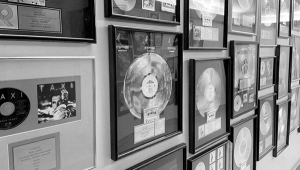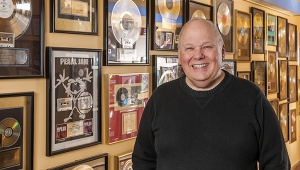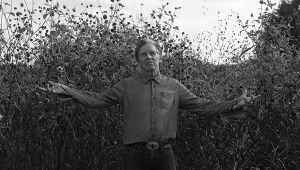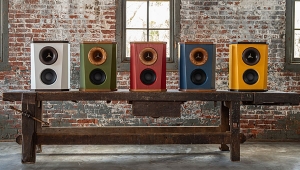| Columns Retired Columns & Blogs |
Paul McGowan: High-End Survivor Page 5
McGowan: They're unusual. One of the dilemmas that I ran into designing an amplifier involved the Power Plant. Since we're not using anything like Bob Carver's "tracking downconverters," or switching power supplies, which I don't particularly like, a conventional class-AB power amplifier is 40% to 50%, maybe 60% efficient. So for an amplifier to produce, let's say, 150W per channel, I've got to be able to have a 600W Power Plant to supply it.
So there's the dilemma: For every power amplifier that I sell, I've got to sell a twice-as-expensive Power Plant to go with it. That gives no real advantage to a PS Audio customer. I mean, if you own a Krell, if you own an Audio Research, well, you're going to have to do that, there's not much I can do about that. But if you want to buy a PS Audio power amp, we thought that there was perhaps something we could do to solve that problem, since we now have control over everything.
We had suspected for a long time, and finally confirmed, that if you divide a power amplifier into its two basic components—the voltage-gain stage at the input and the current-gain stage at the output—it's the voltage-gain stage that is more affected by power-supply anomalies. We made a few experiments and found that about 80% of the improvement of the AC line is found in the voltage-gain stage as opposed to the current-gain stage. That's good news, because the voltage-gain stage doesn't take much in the way of current. So all PS Audio power amps will have a special input plug that will allow you to power a separate power supply for its voltage-gain stage off of a Power Plant P300.
The amplifier will also be based on what we tried to do with the Genesis Stealth. If we now break down a power amplifier's voltage-gain stage, there's the input stage, which is typically a differential pair, and then the output-gain stage, which actually drives the output stage. One of our goals is to completely isolate those two. There's a number of reasons why you'd want to do that, but one of the main reasons is that what's reflected back through the voltage stage to the differential pair can be critical to the amplifier's sound. What we [did in the Stealth] was to isolate those two stages magnetically, with a transformer, [which means] there is no connection groundwise.
This allows us to have in the front-end stage a separate regulated ±40V power supply, just for the diff pair. Because you need up here for the voltage-gain stage [Paul pantomimes a high DC voltage] and down here is what we're trying to do for the differential stage. You couldn't [have such different DC operating voltages for the two stages] because they would normally be direct-coupled. And you don't want to use a capacitor. But there is a way to do it, which is magnetically.
So, our power-amp differential-gain stage is magnetically coupled through a very-high-end, Jensen-like transformer that has 3dB down points at about 4 cycles and about 100,000 cycles. Sonically, it gives the amplifier a very tubelike sound. I'm a fan of tubes—I don't like designing with them, but I do like listening to them.
The other thing that we do that is rather unconventional is that the amplifier's power supply will basically be a Power Plant, in that it will have ±110V rails. A 200Wpc amplifier normally has about ±70V on its power supply; it doesn't need any more. Ours will have a huge amount because we believe that one of the things that really bothers people is dynamic compression. It irritates me beyond any reasonable words, and it's one thing that cues my ear that I'm listening to a piece of electronics. Tubes tend to have less in terms of dynamic constriction than solid-state does—
Atkinson: Because they have such high-voltage power supplies.
McGowan: Exactly. And they have a linear region usually on the order of 10 times higher than a transistor—because of the voltage. So we're taking that approach. Not quite the 400V of a typical tube design, but pretty darn close. For drum whacks, even our 150W amplifier will be able to put out peaks of about 1000W! On quick transients, it will be able to handle dynamic range unlike any amplifier that I'm aware of.
Atkinson: You were involved in phono preamps and preamps at the original PS Audio, then power amps and the first standalone D/A converter. You had an involvement in loudspeakers at Genesis, you did the Digital Lens reclocking unit, and now you're involved in power supplies. Basically, you've been involved in designing and providing products at every stage in the audio reproduction chain, except for maybe turntables and cartridges. What are the challenges that are left for an engineer like yourself?
McGowan: My single biggest goal—and this will be some time in the future—is to fix one of the biggest problems that I find in my own stereo system, which is the horrible tangle of multiple pieces of equipment and cabling and wiring. I can't tell you how many times I've looked behind the equipment rack and just shaken my head and said, "This is all ridiculous. This has gotten out of hand." I mean, I love separates as much as the next man, and I'm guilty as the next guy for having designed so many separates in my life.
Atkinson: And even separates with separate power supplies!
- Log in or register to post comments




































